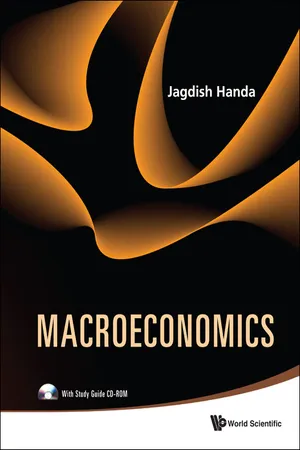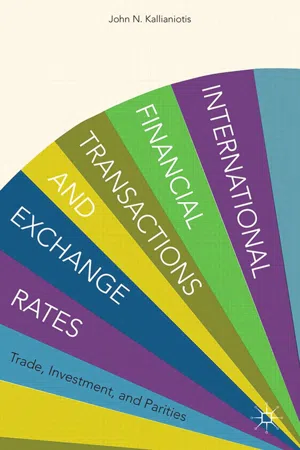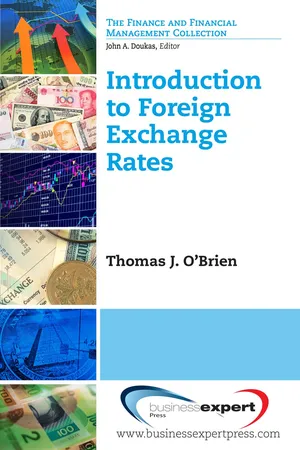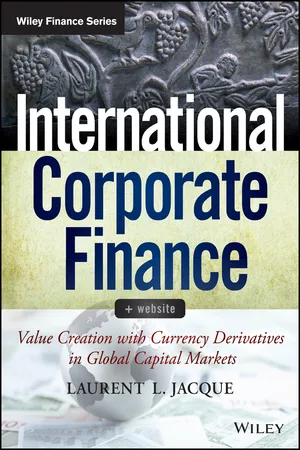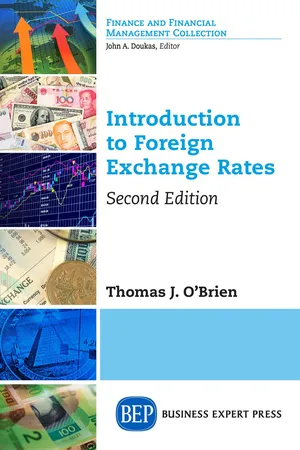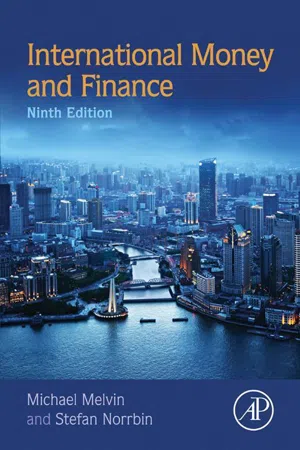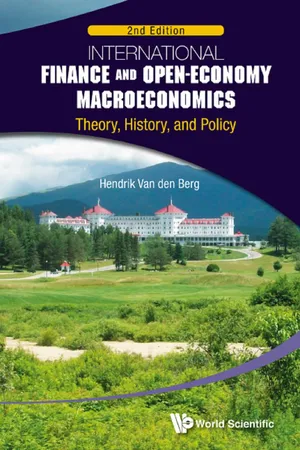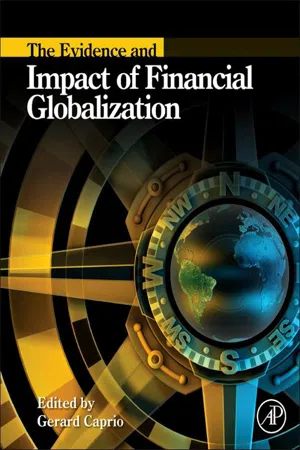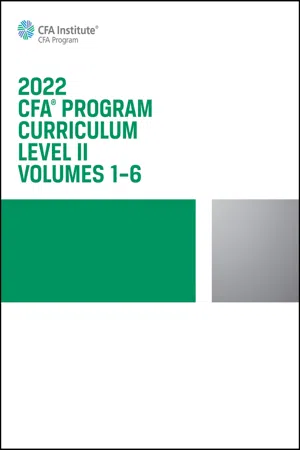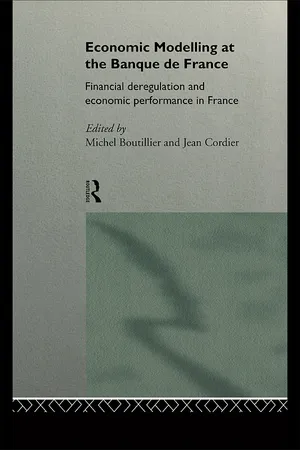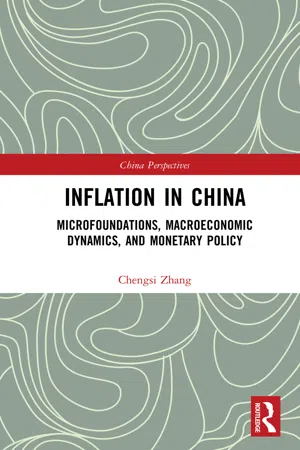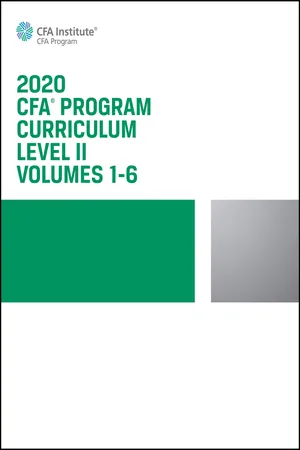Economics
Interest Rate Parity
Interest Rate Parity is a theory that suggests that the difference in interest rates between two countries should be equal to the difference between the forward exchange rate and the spot exchange rate. This concept is important in understanding the relationship between interest rates and exchange rates in the foreign exchange market. It helps to explain how interest rate differentials influence currency values.
Written by Perlego with AI-assistance
Related key terms
Related key terms
1 of 4
Related key terms
1 of 3
12 Key excerpts on "Interest Rate Parity"
- eBook - ePub
Macroeconomics
(With Study Guide CD-ROM)
- Jagdish Handa(Author)
- 2010(Publication Date)
- WSPC(Publisher)
The Interest Parity Theory implies that the interest rates should be identical between them. However, as the following graph shows, there is almost always a differential between them. The Canada T-bill rate was higher in Canada from the early 1970s to the mid-1990s; outside this period, the Canadian rate was sometimes higher and sometimes lower than in the USA. Therefore, the value of the interest rate premium/discount α is usually not zero, even for closely integrated economies, and also not constant over time. 3.5.6 The relative importance of PPP and IRP in determining exchange rates International capital flows are nowadays potentially much larger than the value of commodity flows for developed economies with open capital markets, so that anticipated changes in interest rates can set up massive capital flows. These flows — entering on either the demand or supply side of the foreign exchange market of a country — dominate over other flows and determine the exchange rate — unless the governments have fixed the exchange rate or try to manage it through offsetting sales or purchases of foreign exchange from their reserves. 15 Further, since capital is extremely mobile and very large amounts can be transferred among countries with well-developed financial markets at a few minutes’ notice, IRP determines exchange rate changes on a continuous basis in free exchange markets, while, as we have already argued, PPP holds at best in a long-run context. Hence, in well-developed financial markets, IRP provides the short-term determination of the exchange rates while PPP or its relative version at best only provides a long-term tendency, so that exchange rates determined through IRP can deviate from PPP for considerable periods. 3.6 The Balance of Payments The balance of payments can be defined or presented in an economic or accounting form - eBook - ePub
International Financial Transactions and Exchange Rates
Trade, Investment, and Parities
- I. Kallianiotis(Author)
- 2013(Publication Date)
- Palgrave Macmillan(Publisher)
Graph 2.5 . The Interest Rate Parity line shows the equilibrium state, but in reality transaction costs cause the line to be a band rather than a thin line. Transaction costs are from investment brokerage fees relating to buying and selling securities and foreign exchange cost relating to buying and selling currencies in the spot and forward markets.Interest Rate Parity [equation (2.27)] takes on two distinctive forms: (1) uncovered Interest Rate Parity (CIP) or uncovered interest arbitrage (UIA), which refers to the parity condition that uninhibitedly exposes investors to foreign exchange risk (i.e., unanticipated changes in exchange rates) and (2) covered Interest Rate Parity or covered interest arbitrage (CIA) refers to the condition in which a forward contract has been used to cover (i.e., hedge the foreign exchange exposure) the exchange rate risk.Graph 2.5 Interest Rate Parity (IRP)Note: IRP Line = Interest Rate Parity line (the 450 red line), CIA = covered interest arbitrage, interest rate differential,Source: Economagic. comfporfd= forward premium or forward discount. There is a zone around the IRP line, where covered interest arbitrage is not feasible, due to transaction costs.Each form of the parity condition demonstrates a unique relationship with implications for the forecasting of future exchange rates: the forward exchange rate and the expected future spot exchange rate. Economists have found empirical evidence that covered Interest Rate Parity generally holds, though not with precision, due to the effects of various risks, costs, taxation, and ultimate differences in liquidity. When both covered and uncovered Interest Rate Parity hold, they expose a relationship suggesting that the forward rate is an unbiased predictor of the expected future spot rate (discussed in section 2.1.4.1). - eBook - ePub
- Thomas J. O'Brien(Author)
- 2013(Publication Date)
- Business Expert Press(Publisher)
CHAPTER 6 Topics in Uncovered Interest Rate Parity This chapter covers some applications and issues related to the uncovered Interest Rate Parity (UIRP) condition. We first show the simple expected rate of change of the short-run intrinsic foreign exchange (FX) rate, given the UIRP condition. This concept has important implications in international finance, including converting an asset's cost of capital from one currency into another. The chapter also analyzes the impact on the spot FX rate if a currency's interest rate abruptly changes. This exercise is intended to help us see the dynamic forces that affect FX rates. We shall also describe Siegel's paradox, which is a minor mathematical problem for the UIRP theory. Finally, we shall cover the idea of how real interest rates connect the short-run intrinsic FX rate (consistent with financial market conditions and the UIRP condition) with the long-run intrinsic FX rate (consistent with goods market conditions and the absolute purchasing power parity (APPP) condition.) Expected Rate of Short-Run Intrinsic FX Change If the spot FX rate is correctly valued relative to financial market conditions, the expected rate of FX change is the expected rate of short-run intrinsic FX change. The notation E* (x Sf/$) denotes the expected annualized percentage change in the short-run intrinsic spot FX price of the U.S. dollar (relative to the Swiss franc), where the asterisk conveys the notion of short-run intrinsic FX valuation consistent with financial market conditions - No longer available |Learn more
International Corporate Finance
Value Creation with Currency Derivatives in Global Capital Markets
- Laurent L. Jacque(Author)
- 2014(Publication Date)
- Wiley(Publisher)
Exhibit 6B.1 ) the contending paths from interest rate differentials to expected exchange rate changes via inflation rates or via forward exchange rates.EXHIBIT 6B.1International Parity LinkagesThe reader should be cautioned that, although the international parity relationships are a powerful conceptual framework for understanding exchange rate determination, it is a greatly simplified view of reality that is subject to considerable controversy because it assumes perfect markets for goods, capital, and currencies with minimal interference from government regulation and controls.International Fisher Effect
Irving Fisher’s insight was that the nominal interest rate i can be decomposed into a real interest rate i* and an expected rate of inflation E( ):11which is often approximated as:as long as both real interest and expected inflation are low single-digit numbers.12Consequently, the international Fisher effect postulates that the interest rate differential between the domestic country (d) and foreign country (f) should equal the expected inflation rate differential between those same two countries. If real interest rates are constant over time, fluctuations in interest rates are the result of continuously changing expectations of inflation rates.Thus the differential in expected rates of inflation between the domestic and foreign countries can be expressed as:Purchasing Power Parity
The theory of purchasing power parity (PPP) argues that in the long run, exchange rates should move toward levels that would equalize the prices of an identical basket of goods and services in any two countries. This important relationship was first introduced at some length in the appendix to Chapter 2. In its absolute version, PPP states simply that the prices of identical baskets of goods, when expressed in the same currency, cannot differ between two countries because arbitrageurs will take advantage of such situations until price differences are eliminated. This is nothing other than the Law of One Price, which can be readily extended from representative baskets of goods to the price level of an economy at large, thereby directly linking price indexes in two countries with their exchange rates. Denoting by Pdand Pfthe price level in the domestic country d and the foreign country f - Thomas J. O'Brien(Author)
- 2016(Publication Date)
- Business Expert Press(Publisher)
CHAPTER 6 Topics in Uncovered Interest Rate ParityThis chapter covers some applications and issues related to the uncovered Interest Rate Parity (UIRP) condition. We first show the expected rate of change of the short-run intrinsic foreign exchange (FX) rate, given the UIRP condition. This concept has important implications in international finance, including converting an asset’s cost of capital from one currency into another.The chapter also analyzes the impact on the spot FX rate if a currency’s interest rate abruptly changes. This exercise is intended to help us see the dynamic forces that affect FX rates. The chapter also describes Siegel’s paradox, which is a minor mathematical problem for the UIRP theory.Finally, we cover the idea of how real interest rates connect the short-run intrinsic FX rate that is consistent with financial market conditions and the UIRP condition, with the long-run intrinsic FX rate that is consistent with goods market conditions and the absolute purchasing power parity (APPP) condition.Expected Rate of Short-Run Intrinsic FX ChangeIf the spot FX rate is correctly valued relative to financial market conditions, the expected rate of FX change is the expected rate of short-run intrinsic FX change. Let denote the expected percentage change in the short-run intrinsic spot FX price of the U.S. dollar (relative to the Swiss franc), where the asterisk conveys the notion of short-run intrinsic FX valuation consistent with financial market conditions. If the UIRP condition is the correct model of short-run intrinsic FX value, then is given as a linear approximation in Equation 6.1 .Expected Rate of Short-Run Intrinsic FX ChangeLinear Approximation UIRP Condition(6.1) In Equation 6.1 , the interest rate for the “denominator currency” is subtracted from the interest rate of the “numerator currency.” Let us do a numerical example. Assume , and . The linear approximation in Equation 6.1 says that −0.02, or −2 percent. By way of comparison with the UIRP condition in Equation 5.1 , assume . Thus the UIRP condition in Equation 5.1 says that today’s spot FX rate should be , and the expected rate of intrinsic spot FX change, given that the UIRP condition holds, is (1.57 Sf/$)/(1.60 Sf/$) − 1 = −0.019, or −1.9 percent, So the linear approximation in Equation 6.1 is close.1- eBook - ePub
- Michael Melvin, Stefan C. Norrbin(Authors)
- 2017(Publication Date)
- Academic Press(Publisher)
www.deposits.org , Sep. 2015.Exchange Rates, Interest Rates, and Inflation
If we combine the Fisher Eq. (6.5) and the interest parity Eq. (6.3) , we can determine how interest rates, inflation, and exchange rates are all linked. First, consider the Fisher equation for the United States and the United Kingdom:i $=r $+π $ efor the United States ,andi £=r £+π £ efor the United States .Global investors now want to have as high as possible real returns from their investments. If global markets allow free flow of capital, one might expect that the real returns across countries equalize. If we assume that the real rate of interest is the same internationally, then r $ =r £ . In this case, the nominal interest rates, i $ and i £ , differ solely by expected inflation, so we can write(6.6)i $−i £=π $ e−π £ e(6.6)The interest parity condition of Eq. (6.3) indicates that the interest differential is also equal to the forward premium, or(6.7)i $−i £=π $ e−π £ e= ( F − S ) / E(6.7)Eq. (6.7) summarizes the link among interest, inflation, and exchange rates.In the real world the interrelationships summarized by Eq. (6.7) are determined simultaneously, because interest rates, inflation expectations, and exchange rates are jointly affected by new events and information. For instance, suppose we begin from a situation of equilibrium, where interest parity holds. Suddenly there is a change in US policy that leads to expectations of a higher US inflation rate. The increase in expected inflation will cause dollar interest rates to rise. At the same time exchange rates will adjust to maintain interest parity. If the expected future spot rate is changed, we would expect F - eBook - ePub
International Finance and Open-Economy Macroeconomics
Theory, History, and Policy
- Hendrik Van den Berg(Author)
- 2016(Publication Date)
- WSPC(Publisher)
An alternative approach to testing the interest parity hypothesis is to use a regression equation based on the simplified version of the covered interest parity condition given in Eq. (4.16). We can use the forward exchange rate to serve as a measure of expectations, in which caseNote that (Δe)/et is the percentage change in the exchange rate. The relevant regression equation that tests whether the percentage change in the exchange rate actually equals the difference between domestic and foreign interest rates is thereforeInterest parity is statistically confirmed if estimated values of the coefficients are a0 = 0 and a1 = 1 at a sufficiently high level of statistical significance.The regression equation (4.30) or the equation (4.32) will fail to properly test the interest parity hypothesis if interest rates r and r* are not accurately measured. Inaccurate data on interest rates r and r* are likely because it is not clear which interest rates investors take into consideration when they make their decisions. Different assets offer different returns depending on their risk, maturity, liquidity, and size. Should researchers use the interest rates for short-term bank deposits, short-term government bonds, longer certificates of deposit, or some weighted average of asset returns? Another problem that plagues statistical tests of interest parity is that assets located in different countries are never quite comparable, if for no other reason than that they are denominated in different currencies and therefore subject to the economic policies of different governments.Statistical tests often confirm the covered interest parity condition when data from the eurocurrency markets are used. The eurocurrency market is the global network of large private banks that offer accounts and loans in a variety of currencies in the major money market centers of the world. Because interest rates are for loans in different currencies from the same banks in the same political jurisdiction, there are fewer differences among the assets that could distort the comparability of competing assets. Tests using eurocurrency interest rates and short-term forward exchange rates for the major currencies are therefore likely to offer the least biased tests of regressions such as (4.30) and (4.32). The results of such short-term tests of the interest parity condition are similar to the single-observation “test” we performed earlier in the chapter when we compared spot and forward exchange rates and interest rates for the pound and dollar. When assumptions of free capital movements, similar assets, and the absence of tax and regulatory distortions are satisfied, interest parity is often confirmed by such tests. - (Author)
- 2012(Publication Date)
- Academic Press(Publisher)
Exhibit 29.2 suggests that deviations from CIP are experiencing a new normal, with deviations in the range of 25–50 basis points for the EUR–USD pair rather than in the range of 10–25 basis points which had been observed a decade previously.Conclusion and Cautionary Notes on Parity Deviations
As McBrady et al. (2010, p. 695) so well expressed it, “Interest Rate Parity is a bedrock assumption of international finance.” Over the first half of the twentieth century, comparisons of short-term Treasury Bill rates on a covered basis often showed sizeable departures from parity. For the most part, economists attributed much of these deviations to the costs and risks of executing arbitrage transactions. With the gradual opening up of international capital markets, and especially offshore markets in the 1960s and 1970s, measured departures from CIP shrunk substantially. Economists have come to define the CIP condition as a measure of international capital mobility. By the start of the twenty-first century, economists essentially took CIP for granted at least among the G10 countries and probably much more widely. Sovereigns and private companies were active in international market, searching for minor deviations from CIP and seizing upon them to issue (or buy) foreign bonds, execute a currency swap, and lock in a small, but nearly risk-free, gain.In the aftermath of the global financial crisis, currency bid–ask spreads have widened, counterparty risks seem greater and more uncertain, and in many cases risk capital is more scarce and expensive. In this setting, deviations from CIP have widened considerably relative to a decade ago. The challenge for researchers as well as practitioners is to accurately measure and price the costs of strategies based on deviations from CIP. All observed deviations from CIP are not necessarily efficient market violations. Deviations from CIP can reflect the implicit additional cost and risk of trying to utilize the lower cost, or higher yielding currency on a covered basis. Measuring those costs, and recalibrating the efficiency and mobility of international capital markets is a new challenge for financial economists.- eBook - ePub
- (Author)
- 2021(Publication Date)
- Wiley(Publisher)
As noted above, the various parity relationships usually do not hold over short time horizons. However, studies show that over longer time periods, there is a discernible interaction among nominal interest rates, exchange rates, and inflation rates across countries, such that the international parity conditions serve as an anchor for longer-term exchange rate movements. We now summarize the key international parity conditions and describe how they are all linked.- According to covered Interest Rate Parity, arbitrage ensures that nominal interest rate spreads equal the percentage forward premium (or discount).
- According to uncovered Interest Rate Parity, the expected percentage change of the spot exchange rate should, on average, be reflected in the nominal interest rate spread.
-
If both covered and uncovered Interest Rate Parity hold—that is, the nominal yield spread equals both the forward premium (or discount) and the expected percentage change in the spot exchange rate—then the forward exchange rate will be an unbiased predictor of the future spot exchange rate.
-
According to the ex ante PPP approach to exchange rate determination, the expected change in the spot exchange rate should equal the expected difference between domestic and foreign inflation rates.
-
Assuming the Fisher effect holds in all markets—that is, the nominal interest rate in each market equals the real interest rate plus the expected inflation rate—and also assuming that real interest rates are broadly the same across all markets (real Interest Rate Parity), then the nominal yield spread between domestic and foreign markets will equal the domestic–foreign expected inflation differential, which is the international Fisher effect.
-
If ex ante
- eBook - ePub
- Michel Boutillier, Jean Cordier, Michel Boutillier, Jean Cordier(Authors)
- 2003(Publication Date)
- Routledge(Publisher)
t+1. Hence, when home and foreign assets are perfect substitutes and exchange rates are fixed, international arbitrage ensures the equalization of interest rates of the two countries.However, if exchange rates vary over time this can induce capital gains or losses to the investor, as measured by the expected change in the exchange rate, denoted s. Therefore, to make the investor indifferent between the holdings in two currencies, the expected change has to match the corresponding interest rate differential. In the absence of transaction costs, the expected yields of the two investments are equivalent when equation (1) holds:where Et (Δ St +1 ) is the expected change in S, the logarithm of the exchange rate, which is proxy for (Et (st +1 )–st )/st .Neglecting the cross-term of the left-hand side and considering that the two assets ma not be perfect substitutes, the condition can be proxied by:where κ denotes a risk premium. Henceforth, equation (2) will be referred to as the uncovered interest parity condition.The analysis of specifications derived from equation (2) has to account for the underlying time-series behaviour of the exchange rate expectations. This unobservable variable may depend on the degree of flexibility with which the exchange rate system operates. For instance, we would expect UIP specifications involving the dollar to be different from those involving currencies within the EMS.Exchange rates’ expectations for flexible and quasi-fixed rates
With a fully flexible exchange rate, say the dollar-mark rate, we can assume that the exchange rate follows a random walk, as the findings in the bulk of the empirical literature suggest. The random walk behaviour is related to the efficiency of the currency markets, since it implies that the best predictor for the exchange rate is simply today’s value (see Meese and Rogoff (1983, 1984) for empirical evidence in favour of this assumption). This means that the change in the exchange rate reads: - eBook - ePub
Inflation in China
Microfoundations, Macroeconomic Dynamics, and Monetary Policy
- Chengsi Zhang(Author)
- 2020(Publication Date)
- Routledge(Publisher)
Figure 13.4 Growth rate of money supply in China: January 2004–December 2010. Source: People’s Bank of China.13.2.2 Uncovered interest parity
McKinnon (2007) also pointed out that there is a parity relationship between China and the United States, that is, the interest rate difference between the two countries is basically equal to the corresponding exchange rate change rate. To illustrate this relationship, McKinnon compared the one-year London Interbank Offered Rate (LIBOR) of the US dollar with the one-year central bill rate issued by the People’s Bank of China in 2004–2006, and found that this interest rate difference was consistent with the change rate basis of RMB against the US dollar, namelyΔs t=i t d−i t f(13.3) Where i is the nominal interest rate and other symbols have the same meanings as above.McKinnon pointed out that since China’s exchange rate reform in 2005, the interest rate of China’s central bank bill has been basically determined by the appreciation path of RMB against the US dollar through the Interest Rate Parity relationship of Equation 13.3. In particular, the fact that the US dollar interest rate is higher than the corresponding RMB interest rate in this period shows that the holders of RMB assets are willing to accept a lower rate of return due to the appreciation trend of RMB against the US dollar, while the holders of US dollar assets are just the opposite. This kind of situation coincides with the content of the parity relation of the interest rate. According to McKinnon, there is downward pressure on the return on RMB assets as the RMB continues to appreciate.However, it seems that the interest rate levels of China and the United States are not completely subject to the endogenous decision mechanism of exchange rate changes; especially after mid-2006, the above Interest Rate Parity relationship has changed significantly. The key point is that McKinnon (2007) did not consider the inflationary pressure caused by the high growth of China’s money supply after the appreciation of the RMB, and underestimated the huge impact of the US subprime mortgage crisis on the Fed’s interest rate policy. To illustrate the problem, Figure 13.5 depicts the dynamic path of the one-year dollar LIBOR and central bank bill yield, interest rate difference, and RMB appreciation against the US dollar from January 2004 to May 2008. As can be seen from Figure 13.5 - (Author)
- 2019(Publication Date)
- Wiley(Publisher)
The difference in expected inflation rates equals the expected change in the exchange rate. Combining these two expressions, we derive the following:The nominal interest rate spread is equal to the difference in expected inflation rates. We can therefore conclude that if uncovered Interest Rate Parity and ex ante PPP hold,(rf – rd ) = 0.The real yield spread between the domestic and foreign countries (rf – rd ) will be zero, and the level of real interest rates in the domestic country will be identical to the level of real interest rates in the foreign country.The proposition that real interest rates will converge to the same level across different markets is known as the real Interest Rate Parity condition.Finally, if real interest rates are equal across markets, then it also follows that the foreign–domestic nominal yield spread is determined solely by the foreign–domestic expected inflation differential:This is known as the international Fisher effect .15The international Fisher effect and, by extension, real Interest Rate Parity assume that currency risk is the same throughout the world. However, not all currencies carry the same risk. For example, an emerging country may have a high level of indebtedness, which could result in an elevated level of currency risk (i.e., likelihood of currency depreciation). In this case, because the emerging market currency has higher risk, subtracting the expected inflation rate from the nominal interest rate will result in a calculated real interest rate that is higher than in other countries.16
Index pages curate the most relevant extracts from our library of academic textbooks. They’ve been created using an in-house natural language model (NLM), each adding context and meaning to key research topics.
Explore more topic indexes
Explore more topic indexes
1 of 6
Explore more topic indexes
1 of 4
